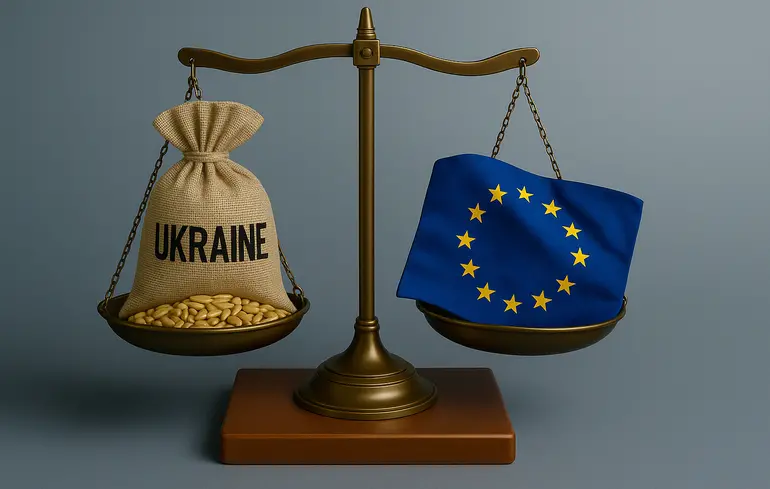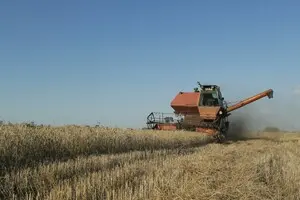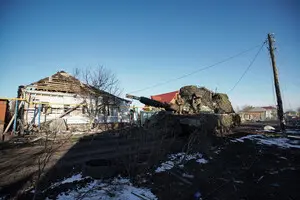EU Tariff-Free Access Expires: 4 Scenarios for Ukraine’s Exports

A tariff-free access to the EU market for many Ukrainian goods, which has been in place since 2022 to enable Ukraine to export its agricultural goods by land and avoid the blocked Black Sea routes, is set to expire in early June. The most crucial are the tariff quotas on specific categories of Ukrainian agricultural products. These preferential measures have been essential in supporting Ukrainian exports during wartime, but they are likely to be discontinued as of June 5.
If the EU reverts to the previous free trade agreement conditions with tariff quotas, considered the worst-case scenario, Ukraine stands to lose $1.5 billion in annual exports to the EU. This would primarily hit the agricultural sector, where quotas limit exports of wheat, poultry, eggs, sugar, honey, and several others, as reported in the study of the Institute for Economic Research in cooperation with Berlin Economics titled "The Expiration of EU Autonomous Trade Measures for Ukraine: What's Next — Four Scenarios and Implications."
Yes, of course, friendship, support, and solidarity with Ukraine, which has become a victim of Russia’s full-scale invasion, remain strong. But (and that’s the key word) EU farmers should not have to suffer from having to compete with Ukrainian agricultural products. It's worth recalling how Polish farmers blocked the transit of Ukrainian grain exactly one year ago.
Attention should also be paid to a recent statement by Polish Prime Minister Donald Tusk at the opening of the European Forum for New Ideas. He said that it is time to restructure and "re-Polonize" Poland’s economy, markets, and capital. He emphasized that Poland will not be a naïve partner in what is becoming an increasingly brutal competition of self-interest on global markets.
The trade preferences introduced in 2022 became a significant support mechanism for Ukraine’s wartime economy. However, several EU member states—including Poland, Hungary, and France—oppose the extension of these measures. Poland, Hungary, Slovakia, and Bulgaria have already imposed unilateral restrictions on the import of Ukrainian grain. Thus, the potential consequences of revoking the current trade preferences have become the focus of a joint research study.
The Core of the Issue
In June 2022, the EU introduced Autonomous Trade Measures (ATMs), which temporarily granted Ukraine full access to the EU market, going beyond the commitments outlined in the Deep and Comprehensive Free Trade Area (DCFTA). These measures abolished or suspended tariff barriers, particularly tariff rate quotas (TRQs) previously applied under the DCFTA.
As a result of the ATMs, Ukrainian exports to the EU of goods that were previously subject to quotas more than doubled, from $2.3 billion in 2021 to $4.7 billion in 2024. However, these measures are set to expire in early June 2025, and all indications suggest they will not be extended. This creates significant uncertainty regarding the future regulatory environment for Ukrainian trade.
Breaking down the impact of the ATMs on Ukrainian exports reveals the following picture:
- Exports exceeding the quotas established under the DCFTA rose to $4.0 billion in 2024, compared to $1.8 billion in 2021.
- The EU's share of Ukrainian exports of goods subject to quotas increased to 42% in 2024.
- The number of product categories with exports exceeding quota limits grew from 11 in 2021 to 18 in 2024.
The main categories of Ukrainian exports to the EU in 2024 were:
- Corn – $2.3 billion, nearly double the 2021 figure;
- Wheat – $1.1 billion, a 22-fold increase compared to 2021;
- Poultry – $392 million, 1.8-fold increase;
- Sugar – $204 million, an 18-fold increase compared to 2021.
What will happen after the expiration of the Autonomous Trade Measures? The researchers have proposed several scenarios, ranging from pessimistic to cautious to optimistic. Let’s take a glance.
Pessimistic Scenario
If the original Deep and Comprehensive Free Trade Area quotas are rolled back, Ukrainian exports to the EU would decline by $1.499 billion compared to 2024. Unfortunately, the losses wouldn’t stop there—an additional $89 million would be lost due to reduced corporate income tax revenues. Altogether, Ukraine would lose about 3.6% of its total exports and 0.8% of its national GDP.
These are significant figures, especially considering the country's economy is in an ongoing crisis and its macroeconomic stability heavily depends on foreign currency inflows, a large portion of which come from exporters.
And those exporters are unlikely to be any wealthier, as reverting to the original DCFTA quotas would result in the reintroduction of tariffs on 85% of Ukrainian exports to the EU. That’s going to hurt.
Less Pessimistic Scenario
If the EU decides to reinstate DCFTA quotas only for a number of sensitive goods, while eliminating quotas for all others, Ukrainian exports to the EU would still decline by approximately $1.196 billion compared to 2024.
The fiscal impact on Ukraine’s budget would be less dramatic, though the loss of $69 million in revenue is still significant. In total, Ukraine’s economy would lose about 2.9% of total exports and 0.7% of GDP.
The so-called sensitive goods include wheat, corn, oats, poultry, sugar, and honey. Trade in wheat and sugar, in particular, may once again fall under the constraints of DCFTA quotas.
Optimal Scenario: Increasing Quotas for Sensitive Goods, Removing Others
According to analysts, this scenario is quite realistic despite the current complexity of negotiations over the future of Ukraine–EU trade relations. On the one hand, it would address the concerns of European farmers. On the other hand, it would minimize Ukraine’s losses, for example, if the EU were to lift quotas on the export of industrial goods.
In this case, both Ukraine and the EU would largely maintain the status quo, and Ukraine might even come out slightly ahead. Here’s how researchers envision it:
- an increase in Ukrainian exports to the EU by $77 million compared to 2024;
- fiscal effect for Ukraine: an additional $5 million in revenue;
- fiscal effect for the EU: a loss of $8 million in revenue;
- impact on Ukraine’s economy: Export growth would amount to about 19% of total exports and 0.04% of Ukraine’s GDP (2024).
Implementing this scenario would help maintain the status quo, preserving vital support for Ukraine while also setting limits on the expansion of Ukrainian exports until full EU membership is achieved.
And finally, a less realistic, but still possible scenario.
Very Optimistic Scenario
Researchers envisioned what would happen in the event of full trade liberalization with the EU. Here’s what that would look like:
- an increase in Ukrainian exports to the EU by $290 million compared to 2024;
- fiscal effect for Ukraine: an additional $21 million in tax revenues;
- fiscal effect for the EU: a loss of $8 million;
- impact on Ukraine’s economy: Compared to 2024, export growth would amount to about 0.7% of total exports and 0.2% of Ukraine’s GDP.
Under these fantastic conditions, the biggest beneficiaries would be Ukrainian poultry and sugar producers.
The resulting picture resembles the current status quo under the Autonomous Trade Measures, but with the added benefit of long-term predictability—something that is sorely lacking under the current temporary measures. However, existing issues related to Ukrainian exports to certain EU countries would remain unresolved and might even worsen, which makes this scenario less realistic despite its appealing outcomes.
***
The study findings highlight the importance of finding a balanced solution that accounts for both the needs of Ukrainian exporters for stable access to the EU market and the concerns of certain EU member states regarding the impact of Ukrainian imports on their domestic markets.
The optimal scenario could be a reasonable compromise. It envisions setting quotas for sensitive goods at the actual 2024 export levels while lifting all other quotas. This would allow the majority of current trade flows to continue until Ukraine achieves full integration into the EU.
Unfortunately, such an outcome can only be achieved through productive negotiations with European partners, with an emphasis on several key points that for a significant portion of Ukrainian products, the EU market is not the final destination, but rather a transit corridor; that European logistics hubs and transport operators are deeply interested in this transit as a reliable source of income; and that new tensions in global trade are a reason to strengthen ties with stable, dependable suppliers—not isolate from them.
Regrettably, as of today, such dialogue is not taking place despite the fact that just over a month remains before the current trade measures expire.
ZN.UA Reference
Methodological Notes
The study is based on the following key elements:
- an assessment of baseline data from Ukrainian sources (prices) and European sources (volumes);
- a partial equilibrium model used to estimate the effects;
- the assumption that the fiscal impact for Ukraine is calculated as foregone corporate income tax from the additional profits generated by the Autonomous Trade Measures;
- the classification of sensitive goods is based on criteria such as the level of EU tariffs applied outside of quota, existing import bans on Ukrainian goods introduced since 2023, and the implementation of an emergency brake mechanism on specific imports.
Please select it with the mouse and press Ctrl+Enter or Submit a bug

















 Login with Google
Login with Google